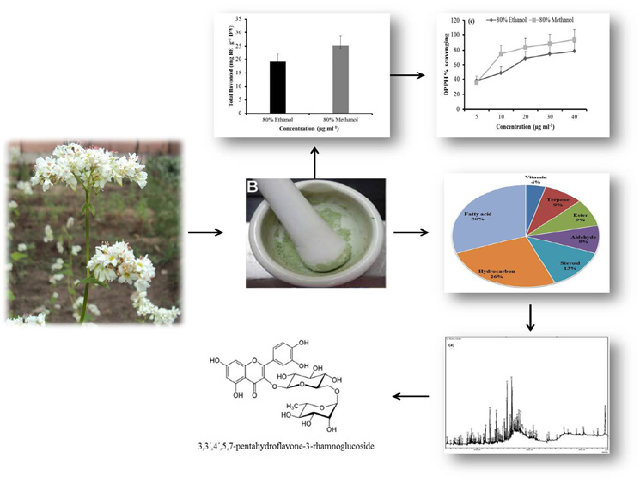Metabolite Fingerprinting and Antioxidant Potential of Tartary Buckwheat- an Underutilized Pseudocereal crop from Kashmir Region
DOI:
https://doi.org/10.5530/fra.2017.1.15Keywords:
Antioxidants, Metabolite fingerprinting, Tartary buckwheat, GC-MS, DPPH, FRAPAbstract
Objective: Buckwheat is an underutilized pseudocereal crop used as a staple food especially in Himalayan regions. The aim of the present study was to evaluate the phytochemical screening, antioxidant potential and metabolite profiling of tartary buckwheat extract. Methods: Tartary buckwheat leaf samples were tested for total phenols, flavonoids and in vitro antioxidant potential in terms of total antioxidant activity, free radical scavenging (superoxide, hydrogen peroxide) and DPPH assay. GC-MS profiling was done to identify and quantify the various metabolites from the methanolic leaf and groat extract. Results: Preliminary phytochemical screening of methanolic extract revealed the presence of alkaloids, flavonoids, phenols, tannins, saponins, phlobatannins, coumarins, glycosides and anthoquinones. Methanolic extract exhibits higher TPC (28.32 ± 5.31 mg gallic acid equivalent g-1 DW) and TFC (25.18 ± 3.5 mg rutin equivalent g-1 DW). DPPH radical (EC50=1.8 μg ml-1) and H2O2 scavenging (EC50=0.103 μg ml-1) potential of tartary buckwheat leaf extract shows promising results. From GC-MS metabolite fingerprinting, over 111 and 24 metabolites were identified among leaf and groat extract respectively. The major compounds present in the extracts were fatty acids, hydrocarbons, steroids, terpenoids, esters, organic acids and aldehydes with excellent pharmaceutical properties. Conclusion: The tartary buckwheat extract were found to contain numerous metabolites with potent antioxidant and other pharmacological actions. Thus, tartary buckwheat could be a promising alternative in functional food sector to improve social well-being and neutraceutical to diminish malnutrition especially for the impoverished community.
Downloads
Metrics





